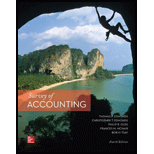
a.
Prepare an amortization table.
a.
Explanation of Solution
Amortization Schedule:
A schedule that gives the detail about each loan payment and shows the allocation of principal and interest over the life of the note, or bond is called amortization schedule.
Amortization table is prepared as follows:
| Amortization Table for Bonds Premium | ||||
| Date | Cash Payment ($) | Interest Expense ($) | Premium Amortization ($) |
Carrying Value ($) |
| January 1, 2014 | 124,920 | |||
| December 31, 2014 | 9,600 (1) | 8,744 (2) | 856 (3) | 124,064 (4) |
| December 31, 2015 | 9,600 (1) | 8,684 (5) | 916 (6) | 123,148 (7) |
| December 31, 2016 | 9,600 (1) | 8,620 (8) | 980 (9) | 122,168 (10) |
| December 31, 2017 | 9,600 (1) | 8,552 (11) | 1,048 (9) | 121,120 (13) |
| December 31, 2018 | 9,600 (1) | 8,480 (14) | 1,120 (15) | 120,000 (16) |
| Totals | 48,000 | 43,080 | 4,920 | |
Table (1)
Working note 1: Calculate the cash payment from 2014 to 2018.
Working note 2: Calculate the interest Expense as on December 31, 2014:
Working note 3: Calculate the premium amortization as on December 31, 2014:
Working note 4: Calculate the carrying
Working note 5: Calculate the interest Expense as on December 31, 2015:
Working note 6: Calculate the premium amortization as on December 31, 2015:
Working note 7: Calculate the carrying value of bond as on December 31, 2015:
Working note 8: Calculate the interest Expense as on December 31, 2016:
Working note 9: Calculate the premium amortization as on December 31, 2016:
Working note 10: Calculate the carrying value of bond as on December 31, 2016:
Working note 11: Calculate the interest Expense as on December 31, 2017:
Working note 12: Calculate the premium amortization as on December 31, 2017:
Working note 13: Calculate the carrying value of bond as on December 31, 2017:
Working note 14: Calculate the interest Expense as on December 31, 2018:
Note: $8,478.4 rounded to $10,597.
Working note 15: Calculate the premium amortization as on December 31, 2018:
Working note 16: Calculate the carrying value of bond as on December 31, 2018:
b.
State the item that would appear on the Balance sheet of 2015.
b.
Explanation of Solution
Balance sheet: Balance Sheet is one of the financial statements which summarize the assets, the liabilities, and the Shareholder’s equity of a company at a given date. It is also known as the statement of financial status of the business.
- The item that would appear on the Balance sheet of 2015 is the carrying value of bond liability. The premium amount is included while, reporting the carrying value ($123,148).
- The face value of the bond and the premium received on bond is disclosed in the notes to the financial statements. Alternatively, the face value plus the premium could be shown in the following way:
| Particulars | Amount ($) |
| Bond liability | 120,000 |
| Add: Bond Premium (17) | 3,148 |
| Carrying value | 123,148 |
Table (2)
Working note 17: Calculate the total premium on bond:
c.
State the item that would appear on the income statement of 2015.
c.
Explanation of Solution
Income statement: Income statement is the financial statement of a company which shows all the revenues earned and expenses incurred by the company over a period of time.
The statement of income will report interest expense of $8,684.
d.
State the item that would appear on the statement of cash flows of 2015.
d.
Explanation of Solution
Statement of cash flows: Statement of cash flows is one among the financial statement of a Company statement that shows aggregate data of all
The cash flow statement will report
Want to see more full solutions like this?
Chapter 7 Solutions
Loose-Leaf for Survey of Accounting

 AccountingAccountingISBN:9781337272094Author:WARREN, Carl S., Reeve, James M., Duchac, Jonathan E.Publisher:Cengage Learning,
AccountingAccountingISBN:9781337272094Author:WARREN, Carl S., Reeve, James M., Duchac, Jonathan E.Publisher:Cengage Learning, Accounting Information SystemsAccountingISBN:9781337619202Author:Hall, James A.Publisher:Cengage Learning,
Accounting Information SystemsAccountingISBN:9781337619202Author:Hall, James A.Publisher:Cengage Learning, Horngren's Cost Accounting: A Managerial Emphasis...AccountingISBN:9780134475585Author:Srikant M. Datar, Madhav V. RajanPublisher:PEARSON
Horngren's Cost Accounting: A Managerial Emphasis...AccountingISBN:9780134475585Author:Srikant M. Datar, Madhav V. RajanPublisher:PEARSON Intermediate AccountingAccountingISBN:9781259722660Author:J. David Spiceland, Mark W. Nelson, Wayne M ThomasPublisher:McGraw-Hill Education
Intermediate AccountingAccountingISBN:9781259722660Author:J. David Spiceland, Mark W. Nelson, Wayne M ThomasPublisher:McGraw-Hill Education Financial and Managerial AccountingAccountingISBN:9781259726705Author:John J Wild, Ken W. Shaw, Barbara Chiappetta Fundamental Accounting PrinciplesPublisher:McGraw-Hill Education
Financial and Managerial AccountingAccountingISBN:9781259726705Author:John J Wild, Ken W. Shaw, Barbara Chiappetta Fundamental Accounting PrinciplesPublisher:McGraw-Hill Education





